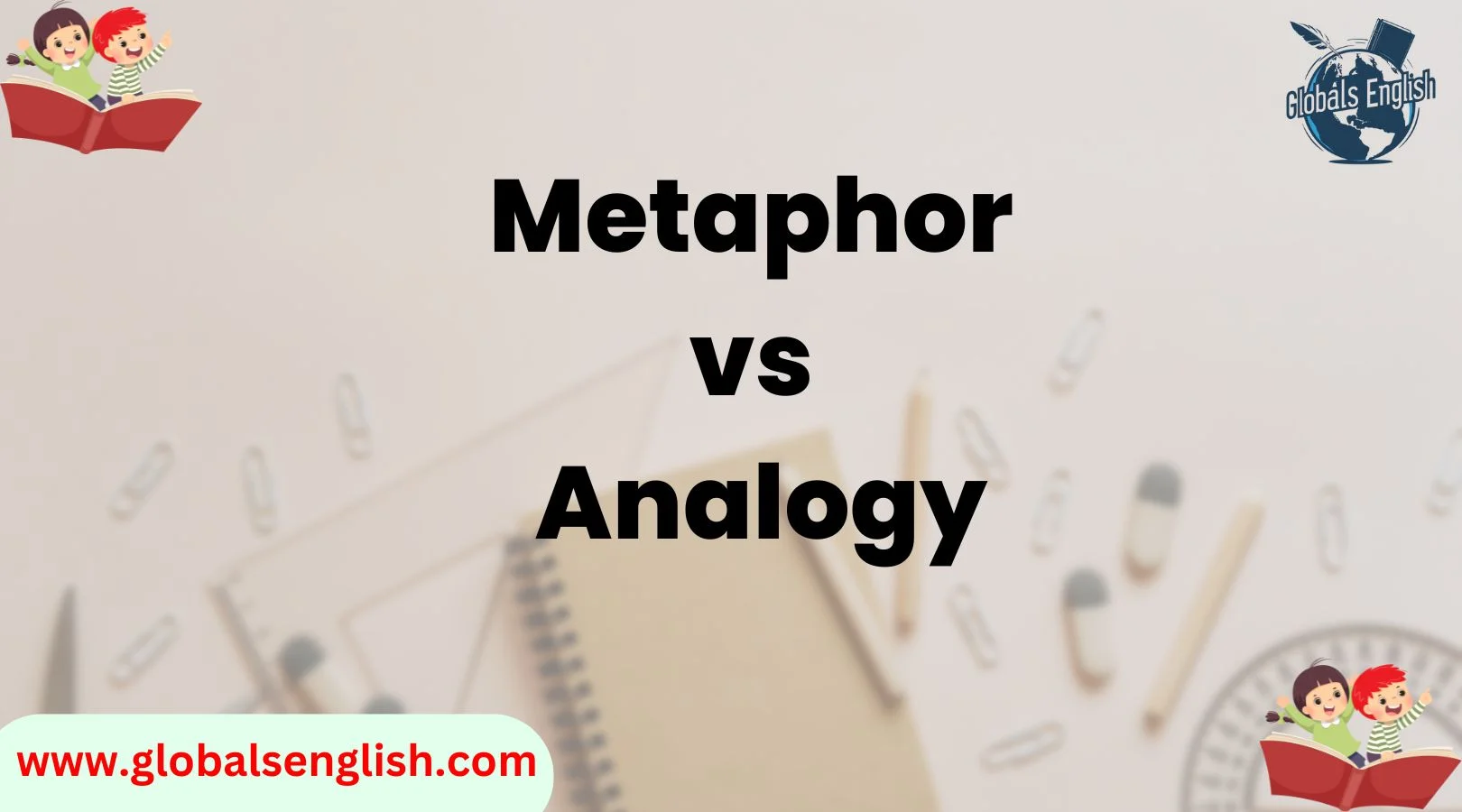When you’re communicating, whether through writing or speaking, clarity is key. But sometimes, finding the right words to explain something can be challenging. This is where metaphors and analogies come into play, offering powerful tools to help illustrate ideas more vividly and effectively.
However, while both are comparisons, they are not the same, and getting them right can make all the difference in how your message is received. So, what exactly sets these two apart?
And how can you use them to communicate more clearly and compellingly? In this article, we’ll explore the real difference between metaphors and analogies, showing you how to use both in your writing and everyday conversations.
Understanding the difference between these two is crucial. Whether you’re an aspiring writer, student, teacher, or someone who simply wants to speak more effectively, knowing how to wield these tools with precision can elevate your communication. Let’s dive in and crack the code!
What Is a Metaphor?
Breaking Down the Basics
A metaphor is a figure of speech that describes an object or action as something other than what it is, creating a symbolic comparison. It directly equates two unrelated things without using “like” or “as,” which are commonly found in similes.
Instead, metaphors say something is something else, inviting the listener or reader to understand the comparison on a deeper, more intuitive level.
For example, take the phrase “Time is a thief.” Here, time isn’t actually a thief, but by equating it with one, the metaphor conveys that time, like a thief, takes away moments from our lives, often without us noticing.
How Metaphors Work in Everyday Language
Metaphors pack a punch. They’re quick, impactful, and often emotional. When used effectively, they can instantly convey complex ideas in a way that’s both memorable and relatable. Metaphors aren’t limited to literature; they show up in conversations, speeches, and advertising campaigns too.
Think about it: Have you ever heard someone say they’re “drowning in work”? They’re not literally submerged in water, but this metaphor vividly conveys the overwhelming nature of their tasks.
Types of Metaphors You Should Know
Metaphors come in various forms, each serving a different purpose. Understanding these types helps you use them more strategically:
- Implied Metaphors: These don’t directly state the comparison. For example, “He’s a lion on the field” implies he’s strong, courageous, and dominating.
- Extended Metaphors: These span several lines or sentences, offering a more detailed comparison. For instance, in Shakespeare’s As You Like It, he compares the world to a stage, extending this metaphor throughout the play.
- Mixed Metaphors: These combine two or more unrelated metaphors. For example, “We need to stay on track and avoid hitting a bump in the road.” While it gets the point across, it sounds jumbled and confusing.
- Dead Metaphors: These metaphors are so commonly used that we no longer recognize them as figurative. Phrases like “head of the house” or “the arms of the chair” are examples of dead metaphors.
- Visual Metaphors: These use imagery to represent an idea, such as in commercials where a mountain might symbolize a challenging goal.
What Is an Analogy?
A Closer Look at Analogies
While a metaphor draws a direct comparison, an analogy explains the relationship between two things by showing how they’re similar. It’s essentially a comparison that helps clarify a concept, making it easier for the audience to understand something complex by relating it to something more familiar.
For example, “Just as a sword is the weapon of a warrior, a pen is the weapon of a writer.” Here, the analogy draws a clear connection between two objects by comparing their roles in their respective contexts, helping you understand the importance of each item in its domain.
Why Analogies Are Powerful Tools
Analogies are often used in teaching, problem-solving, and even in persuasive arguments because they simplify complex ideas. When you can compare a new, difficult concept to something the audience already understands, it opens up a world of clarity.
Analogies are especially useful in education—they bridge the gap between the known and the unknown.
By comparing unfamiliar ideas to something people are already comfortable with, you make new information more accessible.
Common Forms of Analogies
Analogies come in different forms, each used to express relationships in various ways. Here are the most common:
- Proportional Analogies: These draw comparisons that show how two things relate similarly to two other things. For example: “As tree is to forest, so word is to language.”
- Functional Analogies: These explain how two things work in similar ways. Think about comparing the function of a car engine to the human heart. Both provide energy and keep things running.
- Conceptual Analogies: These highlight connections between two abstract ideas. A great example is “love” being compared to “fire”: both can burn, be nurtured, or extinguish.
Metaphor vs Analogy: The Real Difference
Core Distinction in Simple Terms
At the core, metaphors compress meaning by making a direct statement of equivalence (e.g., “Time is a thief”). They don’t explain the comparison but rather present it as fact.
On the other hand, analogies explain the relationship between two things. They provide a clearer, step-by-step breakdown of how one thing is like another, making them more suitable for logical or technical discussions.
For example, “My mind is a computer” (metaphor) compresses the idea of a mind being like a computer, whereas “My mind works like a computer, processing information in a logical sequence” (analogy) explains how the mind and computer share a similar function.
Side-by-Side Comparison Table
| Feature | Metaphor | Analogy |
| Purpose | Suggest similarity | Explain relationship |
| Structure | Implied equivalence | Logical comparison |
| Length | Usually brief | Can be extended or detailed |
| Example | “Time is a thief” | “Time is like money—you spend it” |
How They Can Overlap (But Aren’t the Same)
Metaphors often show up within analogies, but the two should not be confused. For example, in the analogy “Learning is like climbing a mountain”, the comparison of learning to a mountain is a metaphor embedded in the analogy.
When to Use a Metaphor vs When to Use an Analogy
Metaphors: When Brevity and Emotion Win
Metaphors are perfect when you need quick, impactful comparisons. If you’re trying to grab someone’s attention or convey a deep emotional concept in a few words, metaphors are the way to go. They work wonders in poetry, advertisements, and inspirational speeches.
For example, “He was a lion on the field” doesn’t just describe the player’s strength; it evokes an image of power and fearlessness.
Analogies: When Clarity and Logic Matter
Analogies, on the other hand, shine when you need to break down a complicated idea. If you’re explaining a difficult concept to someone unfamiliar with the subject, analogies help make the material more digestible. They’re ideal for essays, tutorials, lectures, and technical writing.
For example, teaching someone to write code might involve the analogy, “Writing a program is like writing a recipe—if you miss a step, the whole thing might fail.”
Checklist: Which One to Choose Based on Purpose
- Use a metaphor when:
- You need emotional impact
- You want to make a point quickly
- Your audience enjoys poetic or creative writing
- You need emotional impact
- Use an analogy when:
- Explaining a complex topic
- Offering clarity in a conversation or article
- Breaking down abstract ideas
- Explaining a complex topic
Examples in the Wild: Famous Uses of Each
Famous Metaphors That Hit Hard
Metaphors often become iconic, with some being used so frequently that they’re deeply embedded in culture. Here are some examples of powerful metaphors:
- Shakespeare’s “All the world’s a stage”: This metaphor sets up the idea of life as a series of acts, exploring the stages of life in a theatrical context.
- MLK’s “I have a dream”: This powerful metaphor doesn’t just speak to the dream of a future; it conjures a vision of possibility and hope.
- Nike’s “Just Do It”: The metaphor here is about pushing through any barriers and just taking action.
Analogies That Changed How We Think
Analogies have been used throughout history to shift how we understand the world. For example:
- Einstein’s elevator analogy: This thought experiment about gravity and acceleration helped explain his theory of relativity in a more tangible way.
- Steve Jobs’ “bicycle for the mind” analogy: This analogy framed personal computers as tools that could amplify human potential, revolutionizing how we see technology.
Misconceptions That Fuel the Confusion
Why People Mix Them Up
It’s easy to see why metaphors and analogies often get confused. They both draw comparisons, and they both imply relationships between things. But remember: metaphors suggest, while analogies explain.
Common Mistakes to Avoid
A common mistake is using a metaphor when an analogy is needed for clarity. For example, saying “Her mind is a jungle” in a technical article about cognitive processes may leave readers scratching their heads, while a well-constructed analogy would have been clearer.
How to Master Both in Your Own Writing
Quick Practice Exercise
To strengthen your understanding of metaphors and analogies, try this: Take a metaphor you’ve heard and expand it into an analogy. Alternatively, find a common analogy and try turning it into a metaphor.
Tips from Writers and Teachers
- Don’t overuse metaphors and analogies. When used sparingly, they can have a powerful effect. Overuse dilutes their impact.
- Know your audience. Use metaphors for emotional impact and analogies for explanation.
- Revise your metaphors and analogies. Make sure they’re clear, relevant, and serve your purpose.
Conclusion: Clear Thinking, Clear Writing
Understanding the real difference between metaphors and analogies empowers you to use both tools strategically.
Whether you want to evoke emotion with a metaphor or clarify a complex concept with an analogy, mastering these tools elevates your writing and communication.
So, next time you’re crafting a message, consider whether a metaphor or an analogy will get your point across more clearly. And remember, as with any tool, practice makes perfect.
FAQs: Understanding “Has Run” in English Grammar
Why is it “has run” and not “has ran”?
Because “run” is the past participle of the verb. In present perfect tense, we always use has/have + past participle. “Ran” is the simple past, which cannot follow “has.”
What is the difference between “ran” and “has run”?
“Ran” describes a completed action in the past with no link to the present. “Has run” is used when the action has some effect now or occurred at an unspecified time before now.
Can I say “He has ran a mile”?
No, that’s incorrect. The correct form is “He has run a mile.”
Is “has run” only used for physical running?
Not at all. “Has run” can also describe managing or operating something (e.g., “She has run a business”) or even idiomatic uses like “The battery has run out.”
How can I remember the correct usage?
Practice common sentences, understand verb forms, and remember that “has” always needs a past participle like “run,” not “ran.”

Emma Brooke is the author and creator behind Globals English, a platform dedicated to helping learners master the English language. With a passion for education and communication, Emma brings years of experience in language teaching and curriculum development. Her mission is to make English learning accessible, engaging, and effective for students worldwide.
